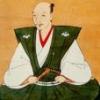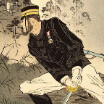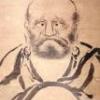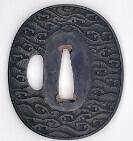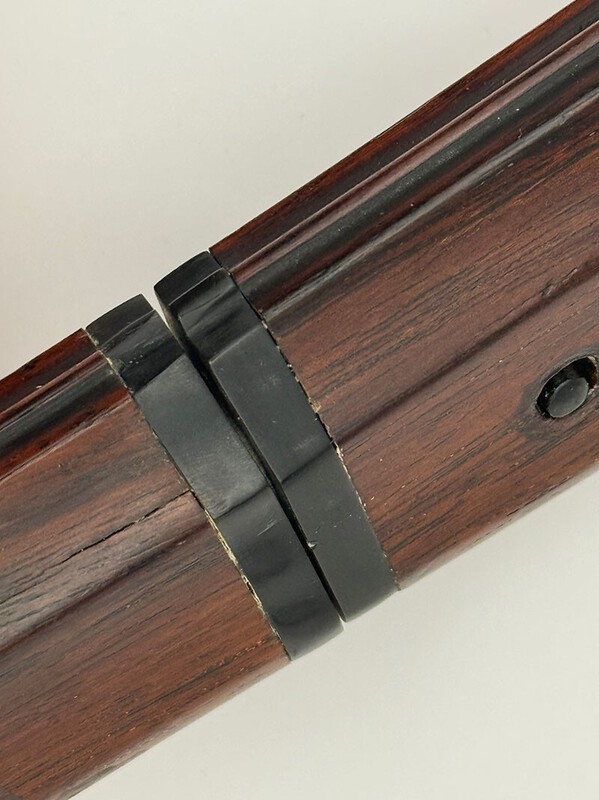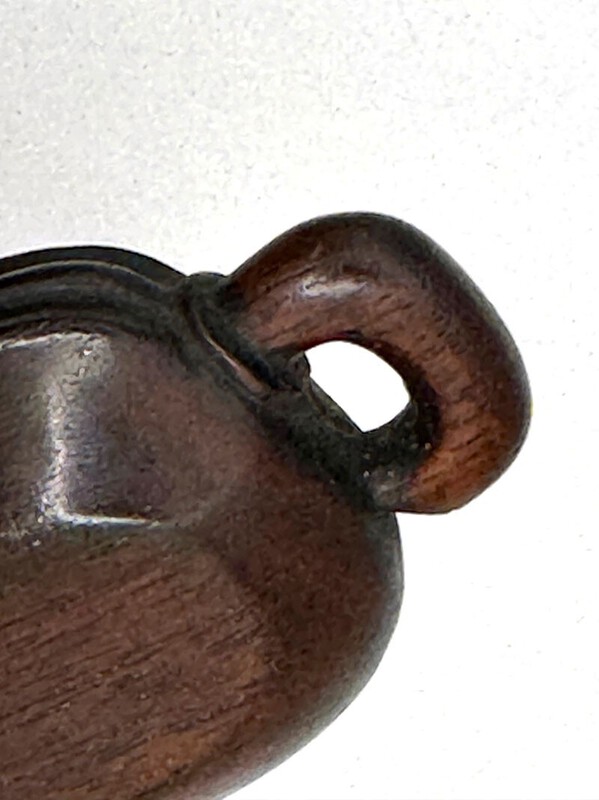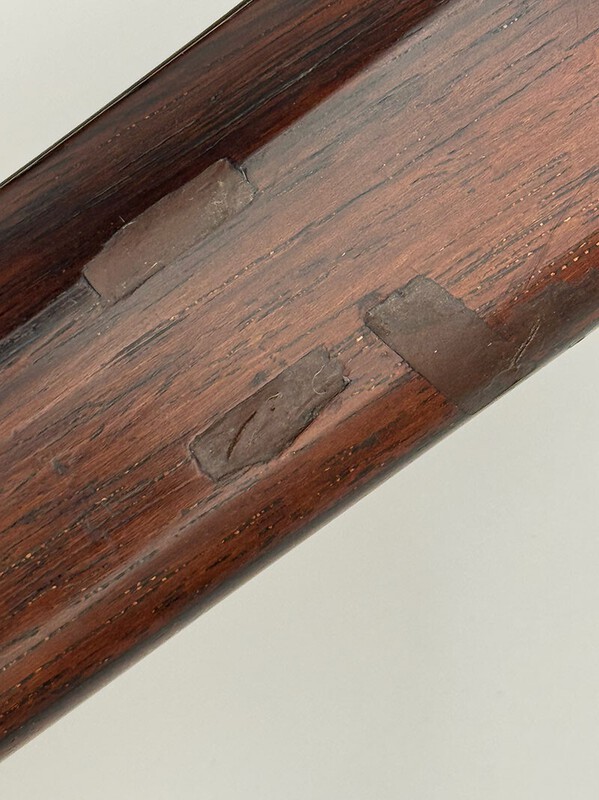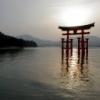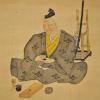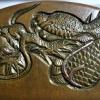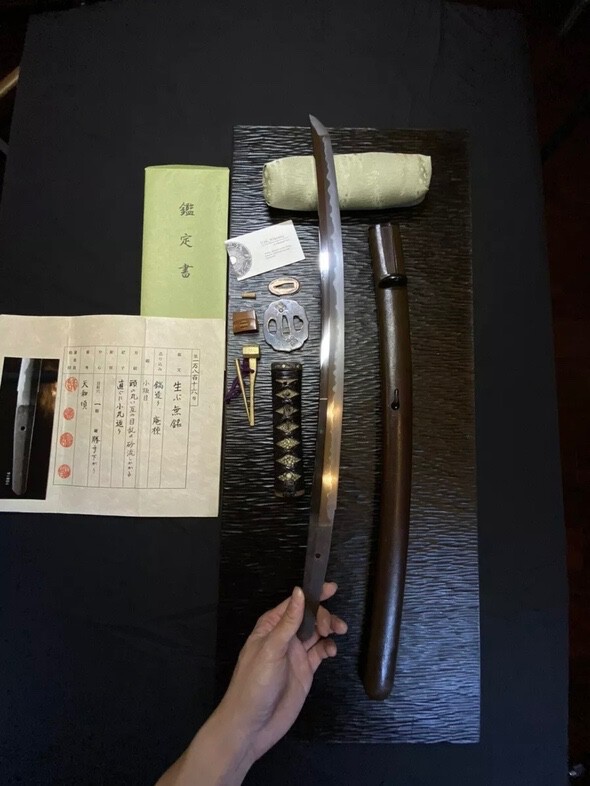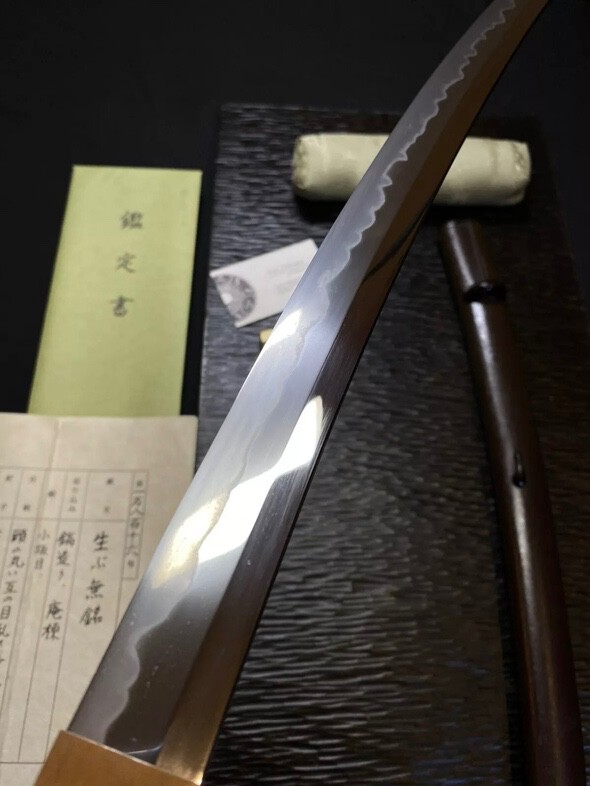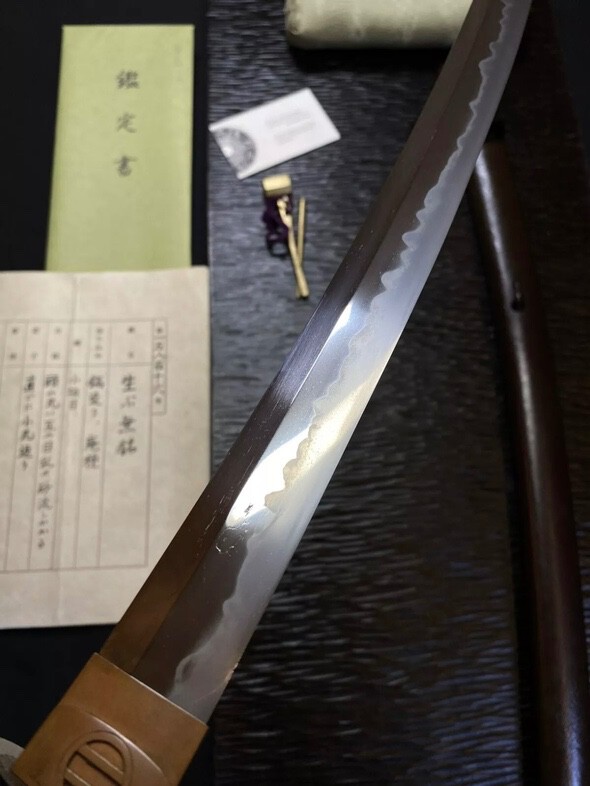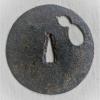Leaderboard
Popular Content
Showing content with the highest reputation on 06/09/2024 in all areas
-
Kawaguchi Saburoemon Noriyasu (Noriyasu can also be read "Hoan") was the Shodai of the Hoan group. He died in 1614, as Jean notes. He worked therefore in the Momoyama Period, not the Muromachi. It is believed he was originally of the Buke, but due to political misfortune (the assassination of Oda Nobunaga in 1582), his status shifted, and he became an armorer, and then, a tsubako. It is, of course, difficult to know the truth of this narrative, but this is what is generally accepted about this smith. Shodai Hoan tsuba are rarely encountered. HIs best works are masterpieces in iron, combining a powerful yakite-kusarashi effect on the surface of the plate, a beautiful "rippling" of the metal in the forging process known as "uwabamigane" (I believe this translates to something like "python skin"), and sensitively-rendered sukidashi-bori to express motif elements. His sword guards often carry that peculiar Momoyama vitality that infuses so many of the arts of that specific time. I believe the reason the NBTHK assigned a "Hoan" ascription to your tsuba, Lex, is that on the lower left quadrant of the omote, something akin to an uwabamigane effect may be seen. In cases where a mumei guard presents with this detail, especially in combination with well-done sukidashi-bori and the yakite-kusarashi surface treatment (sort of a "melty" effect), the NBTHK will often default to a "Hoan" ascription. Personally, I am not convinced, however. I believe that there was another group of tsubako, likely working in Kyoto, that worked in this style (perhaps along with other styles), where acids were applied to the sukidashi-bori elements to achieve the appearance of a slightly melted surface. Such tsuba are predictable in their details: in addition to the above-mentioned use of acids, sukidashi-bori, and sometimes a "rippled iron" (uwabamigane) presentation in the metal, they always have a round sugata, the same or similar sort of "hourglass" tegane around the nakago-ana, and the same shape to the hitsu-ana we see in your tsuba here. They will also often (if not always?) have a very small mark on the right side of the seppa-dai, sometimes on the omote, sometimes on the ura -- not a mei, but a sort of "shop mark" or some such -- that is very easy to miss, owing to its being rather tiny and subtle. These tsuba are never signed, in my experience. I think I may see such a shop mark on the upper right seppa-dai of the omote of your tsuba, Lex. I do not believe these are Hoan tsuba. Hoan had become a pretty big name by the late-Momoyama and into the early-Edo Periods. Signing one's works had become a tradition of sorts for many tsuba-making groups by the early-Edo years, and this is certainly true of the Hoan group. While not circulating in abundance, post-Shodai Hoan guards are found with enough frequency to confirm that they are signed as a matter of course. But the tsuba I describe above -- with their specific and predictable characteristics, and which I am confident your tsuba is one of -- are not signed. Because of this anonymity, and because they bear a superficial resemblance to key features found in Shodai Hoan tsuba (they also are missing important details), the NBTHK default to a "Hoan" reading on these. This is not to disparage this group's work or your tsuba, though, Lex. These are really well-made pieces with a great deal of aesthetic merit, in my opinion. Their combination of acid-etching and sukidashi-bori achieves a beautiful effect. But the peculiar personality of Shodai Hoan is not present in these pieces. If you'd like to see a good example of one of these sword guards, let me know, and I can provide a link.7 points
-
On the polish, this discussion suggests as well as the swordsmith we also should ideally know who the latter day polisher is. The polish is the lens through which we see the sword and there is as much or more in understanding the polish as there is in Kantei Kai guessing the who and when of the swordsmith. It was Albert Yamanaka who said "If a sword does not have sugata then it has nothing". I attach a cropped image from the above OP photos that to me shows that the shinogi ji is not flat, as it is required to be. The original description given says "One thing to note that the current polish is not one hundred percent traditionally done, though this doesn't affect enjoying the blade." True, it all comes down to price and the happiness of a potential buyer scoping the sword. Its all part of our great lifetime journey with the sword... BaZZa.5 points
-
Hi again Victor, sorry if I'm raining on your parade but you can also take issue with the sales blurb: Only the work of the first smith in this line was considered "wazamono" and this isn't something that is passed down to subsequent generations and it wasn't a system that was generalised in the Edo period, but was something formulated from the notes of the Yamada line of executioners who tested blades on criminals. The title of these smiths is Harima Daijo, not Harima no kami. Inaccuracies like this always put me on guard, but at least the seller has been truthful elsewhere so it might be ignorance rather than dishonesty. Also, as a general point, it's worth steering clear of unsigned shinto wakizashi as they aren't especially desireable and you may well take a hit should you need to sell it or just wish to to upgrade your collection. Apologies once again.4 points
-
Hi Victor, I'm with John. The hamon has that painted on look created by overdoing the hadori, either by a bad polisher or to make the hamon wider and more appealing to a buyer. Mostly you can't see the nioi guchi in those photographs so I think that the "real" hamon probably looks quite different to what we are seeing here. If you look, you can see where the hadori has worn away next to the habaki in the penultimate photo as you can see the hada through it. Furthermore, if you look carefully along the length of the blade, through the hadori you can see a straightish line, a darker white, running just above the ha and I suspect that this is the true hamon. I think that the nioi guchi shows through a little in the boshi which looks like it is in reality very thin and yakitsume style with no kaeri and that the turn-back has been added in by the polisher and if you look a little down from the kissaki it looks like the nioi guchi shows through and the hamon is very narrow at that point if what I'm seeing is correct. For me, this is a tired or bland-looking blade that has been pimped but others may see it differently.4 points
-
Here is a link to the sort of tsuba I describe above. Note the "shop mark" to the right of the ura seppa-dai (just about 3:00). It is a beautiful tsuba, extremely well made, but not Hoan, in my opinion only, of course. https://www.tosoguya...oan_rinpo_tsuba.html4 points
-
I bought this tanto a while ago, and it came in this... well... is it a shirasaya? It is made to look like a bean pod, and is beautifully crafted. There is a loop on the end of the hilt that would suit a cord, and there apparently was a kurigata at some point (lost now, and filled with horrible wood filler that I will eventually clean out). Does anyone know anything about fittings like this? The tanto is an armour piercing blade, probably dating to the 17th century, so I don't think that these fittings are original to the blade.3 points
-
3 points
-
3 points
-
You bought a genuine wakizashi in ok koshirae. It has some condition issues and ware, but if the price is right, you started off ok. The kozuka is not bad at all, and the kogatana is in nice polish. It may be entry level but you could do a lot worse.3 points
-
3 points
-
The paper is a bit interesting because it says mumei tsuba, Hoan. Most of the mumei attribution papers will either say Hoan den or kodai Hoan. The use of acid etching was introduced to Japan by the Europeans and there are a number of tsuba shops that utilized this technique. I have seen signed etched tsuba with both Jingo and Umetada mei, and I think most of the tsuba papered to Hoan Den are really one of these two groups. However, low relief acid etching and sukidashi bori can be sometimes hard to tell apart. Here is a brief description of the Hoan group: Shodai Hoan is a mysterious figure. He used Hoan as a personal name, whereas the later Hoan smiths used Hoan as a family name. What little information we have tells us that he was of a Buke family and was initially named Kawaguchi Hoan. He was adopted by Takada Sakyo, who was the lord of Kunotsubo castle in the Kasugai district in Owari Province. Sasano noted in the publication, Tosogu Yuhin Zufu (third edition) that according to Hoan family tradition, “when the the Oda family diminished, Sakyo’s child became an armor maker. He also made tsuba.” The diminishment of the Oda family in Owari can probably be traced to Oda Nobuo being removed from Owari Province in 1590, after quarrelling with Hideyoshi during the Odawara campaign against the Hojo. After losing his position as the heir of Takada Sakyo, Hoan reverted back to the Kawaguchi surname and became a metal worker for the Asano family in Kai Province. The Shodai Hoan is known for his unique and artistic treatment of the iron including a very visible coarse folding of the iron (uwebamegane), acid etched designs, and high heat melting of the the finished surface to create patterns. There is a statement in the Nihonto Koza (Afu translation) concerning the establishment of the Hoan family name: “Upon command of his lord (Asano), he (the Nidai) was called HOAN HISATSUGU, and his decendents also used this name”. What is implied here is that a family line was established in memory of Kawaguchi Hoan. This Hoan familly continued to serve the Asano as iron workers for several generations and apparently were employed in making iron fittings for ships. The Asano were moved from Kai province to Aki and the Hoan group went with them. The later Hoan continued to make tsuba and these are usually signed Hoan Hisatsugu. Also seen are tsuba signed Hoan Kanenobu. It is uncertain as to where he fits in the geneaology.3 points
-
3 points
-
The gourd (hyotan 瓢箪) is my spirit vegetable it seems. As a motif in asian arts and crafts I have grown up with them. It is fitting then that a few Momoyama Period Kanayama tsuba currently in my small collection use the double hyotan (small upper half, larger lower half) as subtly recognizable motifs. Kanayama tsuba are generally described as being symmetrical and with patterns that are abstract, which I find to be especially true for Muromachi Period pieces. Those forged during the early Edo period are also rather stiff and more Tokugawa in their confirmatory sensibility. The Momoyama sensibility is “looser,” freer, with greater vitality and exuberance that is unique to this time and as informed by the aesthetic principles of Tea Ceremony. The two Kanayama tsuba reflect this sensibility and are carved in ji-sukashi. Hyotan have been long used in Japan as containers for sake, water, and flowers; regarded as lucky charms; gourd shapes appear as architectural motifs, cartouches for woodblock prints, and signatures of print artists; multiple gourds on a battle standard (sennari hyotan) is attributed to Toyotomi Hideyoshi who unified Japan in the late 16th century1; and gourds, as it turns out, are among those motifs found on sword guards (tsuba) mounted on katana or wakizashi. From the zen point of view, the hollow gourd denotes emptiness and seeking truth first through an inward gaze at the self.2 For bushi it may have served to ward off bad luck on the battlefield where the possibility of a deadly outcome was ever present. 1Symbols of Japan, Thematic Motifs in Art and Design, Baird, Merrily, Rizzoli International Publications, Inc, 1944 2Zen Painting and Calligraphy, 17th-20th Centuries Exhibition, Woodson, Yoko, Asian Art Museum of San Francisco, Chong-Moon Lee Center for Asian Art and Culture, 2001 Tsuba 1: When I first saw this gem, I almost missed the somewhat abstract hyotan motif that is actually integral to the composition. I thought they were buddhists beads. There are two double hyotan that form the hitsu-ana on either side, anchored on what appear to be stems. There are counter weights above and below. Tsuchime is enhanced in natural sunlight. The patina is a dark brown. It has enough globular tekkotsu on the rim to fuel a rocket to the moon. It is a nearly perfectly round murugata shape. 73.5 x 72.5 x 4.6 (4.9 at mimi) mm Tsuba #2 (please see next post below)2 points
-
2 points
-
Tsuba #2 This one is very similar in iron treatment and features, but the composition is one double hyotan on either side extending to the symmetric hitsu-ana. It is essentially a perfectly round muragata shape. The seller indicated that the other motif is "water well" (ido 井戸) rather than windows or carpenter's squares. I couldn't find a meaning for this motif in Japanese culture, but there is a buddhist practice of offering water poured over figures of Siddhartha at shrines to cultivate the virtues of calmness, clarity, and purity of body, speech, and mind. It is a reminder to diligently cleanse ourselves of attachments, aversion, and delusion through the generating of generosity, compassion, and wisdom. In that way we may reveal our innate buddha nature. 7.0 x 7.0 x 0.5 cm, slightly dished2 points
-
2 points
-
Oi loiks it very much and IMHO this is not only genuine and old but very unique and more than interesting with pleasing contours. I would give it house room. Looking forward to more research on this one. I speculate that it might have bean the head gardener's defence... Now Justyn, can we please see the blade?? BaZZa.2 points
-
If you just want one good genuine sword, saving up your money is the way to go. Use the time to research further and get an eye for quality. Always better to invest more in a decent sword, rather than waste 1500 on something problematic.2 points
-
Went there, seen great stuff. I am glad I got to inspect a lot of great blades and koshirae! My only regret was not picking up that juyo, my eyes were tired at that point so it would've given me a wrong impression. It took me a while to notice but it seemingly still had its registration card on the shirasaya... I didn't really speak to active NMB members though. I did meet Charles White, pretty fun guy to talk with. He said he used to be on this forum years ago. Also attended a lecture on the Uda school to see how much I could actually understand, I was satisfied but I am far from being an expert. They had some technical issues but I can see that they put in some hard work putting it together. I did miss the last one, but by that time I came down with a pretty nasty headache which pretty much made my return trip home a hell. I have learnt three important things; My pockets will really never be deep enough, I like yoroi-doshi blades and Keiun Naohiro (the 5th) is someone I really wish to meet. I hope by the time I can do that he's still able to make a tanto. Overal the experience was good I'll probably attend next year's expo as well.2 points
-
2 points
-
2 points
-
Ubu Tachi This is an Ubu Tachi from the end of the Nambokucho or early Oei. 78.75 cm in length. The sori on this really shows what the O Suriage Tachi looked like before being shortened. It is suggested it may be early Uda or Kai Mihara school , it is unpapered and in old polish and Shira saya I am learning lot from this piece. Many thanks to Mike Yamasaki for selling this to me.1 point
-
Greetings, I won this item at auction. How did I do? It seems to be historically significant. https://bid.poulinau...TRAL-BLADE_i52750601 Peace, Khalid1 point
-
After searching for some time I have found a wakizashi that matches my interest. the polish looks decent, it has an NBTHK paper seems to match the tang (but does the Japanese text match the blade?), a beautiful clear Hamon and the Koshirae..I find it overall beautiful… but as always, I feel like I might be missing something behind the beauty. Therefore I come to you for (hopefully) unbiased advice and expert view. Any question I should ask the seller before hand? what are your thoughts, I thank you in advance as always victor seller description (sorry it’s a long one): Price €1373 Wazamono Wakizashi in fine Koshirae, with NTHK certificate, unsigned, attributed to: 伝 Den 越前三代播磨大掾重高 Echizen Sandai Harima Daijo Shigetaka The 重高Shigetake smithline of 越前Echizen is a representational smithline of the 越前新刀Echizen Shinto school, which the lineage started when the first generation 重高Shigetaka, a student under the famous 美濃Mino smith 兼則Kanenori, migrated to the country of 越前Echizen together with his teacher during Kanbun period (1661~1673) of early Edo period. From then, the school continued their work with great reputation all the way until the 11th generation during the 嘉永Kaie period (1848~1855). The first 3 generations received the title of 播磨守Harima no Kami, The 越前重高Echizen Shigetaka smith group's works were known for great 切れ味Kireaji "sharpness", which their works received the ranking of 業物Wazamono during Edo period's 試し斬りTameshigiri test cutting system. As per the attribution of NTHK, this particular blade is made by the 3rd generation. Note that the 伝Den ("told to be") notation before the attribution means that they are not one hundred percent certain about this attribution, but only thinking this is a likely and probable opinion. as shown in the photos, this particular blade is overall in excellent condition with no significant issues observed. It's overall a rather typical Echizen Shinto blade with such Sugata and Gunome style Hamon. One thing to note that the current polish is not one hundred percent traditionally done, though this doesn't affect enjoying the blade. The Koshirae is very decently done as well, with a lacqueres leather Tsukamaki on the Tsuka, mounted with high quality leaf and spider motif Menuki as well as ratten weaven pattern plum flower motif Fuchikashira as well as Habaki with 丸に二つ引きMaru-ni-Futatsu-biki style 家紋Kamon family crest engraving. Overall a very enjoyable set of art for display and enjoyment Nagasa: 1 Shaku 4 Sun 9 Bu ~45.15cm or 17.78inches1 point
-
1 point
-
I attended that lecture too as well as the one on armor. Both talks were very informative and the Juyo Ko Uda from Henk was a really nice example. I thought the talks were a little light this year. Previous years had many more on both the Friday and Saturday. This year only on Sat. I think it would have been nice if we all had name tags and not just the exhibitors. Udo D. had some really nice swords on display. As did Nick Ruppero. His 28? cut test wakizashi/short katana with Marko Sesko writeup was the standout piece. What a beast of a blade. I ended up buying my first Koto blade. It was the first blade I inspected at the show and I spent the next 2 days doing some research and viewing everything else on display, before committing. It is late Kamakura Yamato blade attributed to the Shikkake school with TH papers and a nice Tensho style koshirae with papered Tsuba and new black Urushi saya. There was a shirasaya with sayagaki by Tanobe san that the vendors had done when they visited him at home last year. Nakago approx 71cm. The blade shows a strong utsuri which had me a little concerned but it does fade when viewing the hada directly. It has that ethereal quality giving the impression it floats above the hada. I will post some pics when I collect the sword next week. In the meantime I will try to upload a closeup video I took of the blade. The same dealer also had a Ko Uda with Hozon papers which had many interesting features. What put me off was the boshi was not existent on one side and there were 2 weird deep scrapes approx 7 mm long on one side and 5 mm on the other. Same place on the blade but hard to see due to them being sandwiched between the tip of the bo-hi and the edge of the shinogi. The explanation offered was it was damage that occurred from a thrusting action through armor. Not sure if I was buying that tbh.1 point
-
The main purpose of bohi is to lighten the blade; they are very common on kazu-uchi mono.1 point
-
1 point
-
They are always added later, as in after the blade was made. lol Bo-hi was common on Bizen blades of that era, so id say its realistic to assume it was done not long after the blade was made. Impossible to be certain.1 point
-
1 point
-
Please more clearly show the nakago (even if unsigned). You occasionally see over-the-top Soshu style works from shinshinto smiths. Late Edo interpretation of hitatsura is what comes to mind.1 point
-
1 point
-
1 point
-
Dear Justyn. I don't think this was ever intended to be shirasaya but rather an interesting and subtle koshirae. Before you remove the filler, which I agree is horrid, you need to do some research to find out what it would have looked like so that you can replace it accurately, I realise that this post is part of that process. ( I have a feeling that I have a reference to one like this somewhere, it will take me awhile but I will have a dig) As always, if in doubt, don't. Find someone who can do it justice. Look forward to seeing the result. All the best,1 point
-
You have better images here - https://www.asianart...=detailAll&Id=152453 I think it is very modern - $60 a little too much for a reproduction but they sell really really bad copies for twice that much. About equivalent quality to this Alva Museum Replica Pendant. Attach a chain and you can have some retro 'Bling' https://www.ebay.com/itm/1934706367381 point
-
That has a NTHK paper rather than a NBTHK paper. Those are two different organizations with different ways of appraising swords. There are several discussions on NMB that discuss the differences.1 point
-
1 point
-
All paintings by the great masters such as Rembrandt, Delacroix, Jericho etc. are restored, as the varnish deteriorates over the years and the paint suffers the effects of light.1 point
-
1 point
-
I had the same thoughts. Not Japanese, however the craftsmanship is above par. So not an authentic netsuke, but rather a netsuke-like object. John C.1 point
-
It is still a masterpiece…..I’m not disputing that at all. Just saying there’s no need to add unnecessary “fake improvements”. My personal taste I guess. However when the value is potentially dramatically and deceptively increased then we have a serious problem.1 point
-
John, I am embarrassed to say I don’t know what NLO means. Never come across that. First glance at the dragon looks old and quite well carved but the signature looks rough. can’t spend time on it right now. Will have better look tomorrow. best. Colin1 point
-
For me, this topic raises some tricky ethical points. I wonder, which would we prefer? A sword with a fake boshi or the same sword in its honest state? Maybe it’s ok to cosmetically improve it for display (museum) purposes but for me personally it’s fakery and making out the sword to be something that it isn’t. Of course as soon as you bring money into the debate it gets a bit more worrying.1 point
-
Hi Bruce, I haven't done any research on RJT mei, but this is what I can tell you about the ones I have (or had). These are my RJT blades with star stamps. Tachi Mei Muto Hidehiro of Fukuoka 18/2 (no longer have this sword) Tachi mei Yamagami Munetoshi of Niigata 18/5 (also have another by him done pre-RJT (no star) signed Tachi mei dated 16/9) Katana mei Nagao Kunishiro of Aomori 19/2 Tachi Mei Nakata Kanehide of Seki 19/5 Tachi Mei Takashima Kunihide of Kyoto 19/8 Hope this is pf some use...1 point
-
No apologies, this thread has been incredibly insightful for me. a simple question about a kissaki has taught me about artificial hamons, fatal flaws, kantei tips, and more. This thread is exactly what I’m hoping for so far!1 point
-
Lex, I found this online: HOAN TSUBA inherit their name from the founder of the Hoan school, SABUROEMON HOAN, who worked in OWARI province. It is believed that he died in 1614, and is buried at KOKUZANJI Temple. After 1600 the school moved to KII province and became retainers to the ASANO clan. They received a stipend of ten KOKU of rice (which is very little). Haynes lists eleven generations, ranging from early Edo to the beginning of the twentieth century. The second generation was known as HISATSUGU, KANENOBU, and YOEMON. Born in 1600, he was the son in law of the first generation HOAN. In 1619 he went with ASANO NAGAAKIRA (1619–1632) to HIROSHIMA. He succeeded his father as head of the family in 1645. He later worked for a branch of the TAKEDA DAIMYO family. Works signed HOAN KANENOBU are not rare, but they seem younger than the dates given to the second HOAN master The third generation was HISATSUGU, as were the next nine generations. The fourth generation also worked for the ASANO DAIMYO, and received a stipend of 800 KOKU of rice. Starting with the sixth generation, it appears they were no longer making sword fittings, but were ship builders. It seems that the tenth generation did make some fittings in the HOAN style, but were primarily ship builders.1 point
-
☆ 昭和十八年三月吉日 A lucky day in March 1943. ☆ 継弘作之 1990 Tsuguhiro saku kore 1990.1 point
-
1 point
-
Because the hi cuts right through the ko-shinogi. Now hi that go far forward are not that uncommon. But breaking the ko-shinogi is. And it is not that aesthetically pleasing. Which implies either the kissaki was taken back to where it is now, or the hi is atobori. But why would someone do that, knowing it looks odd? Hence the most logical explanation is the kissaki was shortened. And since we can't see the boshi...that is a valid supposition. Doesn't mean it's 100% correct, but it is a completely valid assumption. Are you now going to go searching for as any swords as you can with extended hi?1 point
-
Even if is Japan, tell them you are sending it back. Undisclosed flaws is the worst trick.1 point
This leaderboard is set to Johannesburg/GMT+02:00

